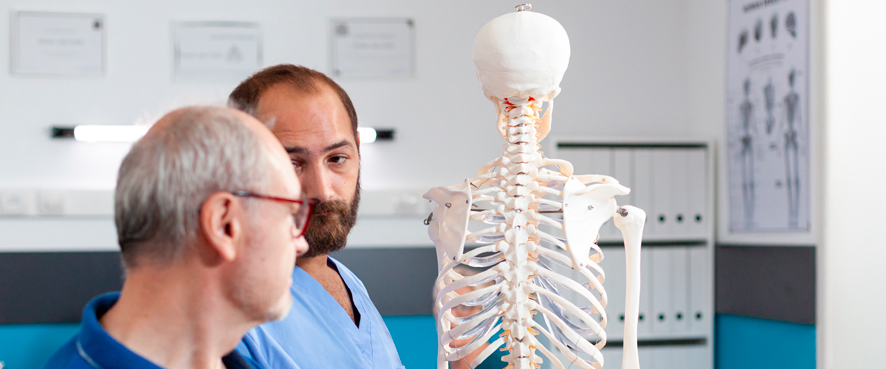The spinal canal is a bony structure comprising 33 vertebrae, extending from the skull to the lower back, enclosing the spinal cord. The different sections of the spinal column consist of varying numbers of vertebrae: cervical (neck) has 7 vertebrae, thoracic (upper back) has 12 vertebrae, lumbar (lower back) has 5 vertebrae, sacral has 5 vertebrae, and coccygeal (tailbone) typically has 4 vertebrae.
The spinal cord is a long, tube-shaped structure made of nerve tissue, located within the spinal canal. It is composed of nerve tissue and supporting cells, extending from the brainstem to the lumbar region of the spinal column. The spinal cord is a vital structure whose function is to transmit nerve signals between the brain and the body.
Spinal Canal Narrowing (Spinal Stenosis): What Is It?
Spinal Stenosis is the narrowing of the spinal canal at one or more locations along the spinal column. The narrowed canal can compress nerve structures (spinal cord and nerve roots) passing through the spine. Spinal canal narrowing most commonly occurs in the lumbar (lower back) and cervical (neck) regions. Some patients with spinal stenosis may be asymptomatic, while others may experience pain, numbness, decreased sensitivity, and muscle weakness. These symptoms may worsen over time. If a patient has such symptoms and they progress over time, timely medical attention should be sought.
The most common cause of Spinal Stenosis is Osteoarthritis (also known as joint calcification), which leads to wear and weakening of the spine. Other factors may include disc herniation, spinal fractures, injuries, cysts or tumors on the spinal cord, and scoliosis. Severe cases of stenosis may require surgical treatment to decompress the spinal cord. Untreated cases of stenosis may result in permanent stiffness, weakness, balance problems, urinary incontinence, or paralysis.
The two main types of spinal stenosis are:
- Cervical Stenosis – narrowing of the spinal canal in the neck region.
- Lumbar Stenosis – narrowing of the spinal canal in the lower back region. This is the most common form of spinal stenosis.
Lumbar stenosis can cause pain in the lower back and legs, as well as stiffness, numbness, and weakness, leading to difficulties in walking. Dysfunction of the bowels and urinary bladder functions may also occur.
Treatment
Treatment for spinal stenosis varies depending on the severity of symptoms and the exact location of the narrowed area. Severe cases may require surgical intervention, while mild cases can often be managed with medication, monitoring, and observation.
In the early stages of spinal stenosis, patients are typically prescribed medication containing pain relievers and undergo a course of physical therapy and rehabilitation. Patients with spinal stenosis are often less active due to pain, which can lead to muscle weakness. The goal of physical therapy and rehabilitation is to maintain muscle tone and endurance, preserve spinal flexibility, and improve body balance. If there is no improvement in the patient’s condition after this treatment course, surgical options are considered.
Implant-Free Treatment with Microsurgical Method
Non-implant treatment of Spinal Stenosis using a microsurgical method aims to decompress the affected area of the spinal canal without placing foreign bodies (implants) in the patient’s body. This method involves widening the narrowed canal from the inside out. It is one of the most modern approaches to treating spinal stenosis and offers several advantages over older surgical techniques that are no longer preferred. Some of these advantages include:
- The surgical procedure is much shorter compared to traditional open surgery.
- The postoperative recovery period for the patient is significantly eased, leading to a shorter recovery time.
- Patients can return to their normal daily activities and work much sooner.
- Since no implants are used, the risk of postoperative infection is minimized.
- The risk of complications such as paralysis or nerve damage is much lower compared to traditional open surgery.
For these reasons, non-implant treatment of spinal stenosis using a microsurgical method is preferred even for elderly patients or those with accompanying health conditions.
For more detailed information or a free second opinion from our Neurosurgery specialists, feel free to contact us!




